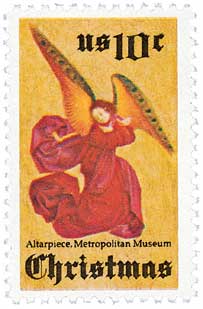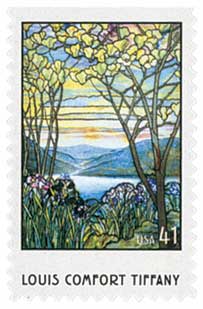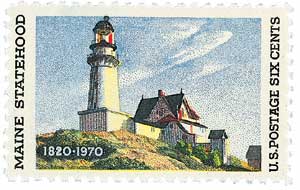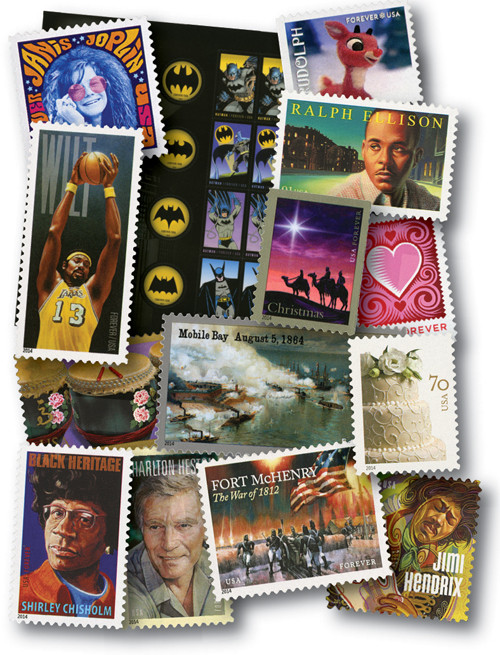
# 4920 - 2014 First-Class Forever Stamp - Hudson River School Paintings: "Distant View of Niagara Falls" by Thomas Cole
The history of “The Met” dates back to 1866 in Paris, France. At that time, John Jay (grandson of Chief Justice John Jay) and a group of Americans visiting Paris began talking about creating a “national institution and gallery of art” to help educate the American people.

Upon returning to the US, Jay, who was president of the Union League Club in New York, worked to gain support from civic leaders, businessmen, artists, art collectors, and philanthropists. Their efforts paid off, and on April 13, 1870, the New York Legislature granted their act of incorporation, “for the purpose of establishing and maintaining in said City a Museum and Library of Art, of encouraging and developing the Study of the Fine Arts, and the application of Art to manufacture and natural life, of advancing the general knowledge of kindred subjects, and to that end of furnishing popular instruction and recreations.”

Initially, the museum consisted of three private European collections totaling 174 paintings and one Roman stone sarcophagus. These included works by Hals, Van Dyck, Poussin, Tiepolo, and Guardi. American businessman John Taylor Johnson also provided artwork for the museum and served as its first president.

The Met first opened to the public on February 20, 1872, at 681 Fifth Avenue. However, its holdings were ever expanding, and this building couldn’t house the entire collection. So in 1873, the museum was moved to the Douglas Mansion at 128 West 14th Street. That would prove to be a temporary location as well, with the museum eventually moving to 1000 Fifth Avenue.
From 1879 to 1895, The Met hosted the Metropolitan Museum of Art Schools to educate people on fine arts. In 1893, another act pertaining to the museum was passed, requiring that the collections “shall be kept open and accessible to the public free of all charge throughout the year.”
Click here to visit the Met’s website, where you can see some of their collections and discover more history.
The history of “The Met” dates back to 1866 in Paris, France. At that time, John Jay (grandson of Chief Justice John Jay) and a group of Americans visiting Paris began talking about creating a “national institution and gallery of art” to help educate the American people.

Upon returning to the US, Jay, who was president of the Union League Club in New York, worked to gain support from civic leaders, businessmen, artists, art collectors, and philanthropists. Their efforts paid off, and on April 13, 1870, the New York Legislature granted their act of incorporation, “for the purpose of establishing and maintaining in said City a Museum and Library of Art, of encouraging and developing the Study of the Fine Arts, and the application of Art to manufacture and natural life, of advancing the general knowledge of kindred subjects, and to that end of furnishing popular instruction and recreations.”

Initially, the museum consisted of three private European collections totaling 174 paintings and one Roman stone sarcophagus. These included works by Hals, Van Dyck, Poussin, Tiepolo, and Guardi. American businessman John Taylor Johnson also provided artwork for the museum and served as its first president.

The Met first opened to the public on February 20, 1872, at 681 Fifth Avenue. However, its holdings were ever expanding, and this building couldn’t house the entire collection. So in 1873, the museum was moved to the Douglas Mansion at 128 West 14th Street. That would prove to be a temporary location as well, with the museum eventually moving to 1000 Fifth Avenue.
From 1879 to 1895, The Met hosted the Metropolitan Museum of Art Schools to educate people on fine arts. In 1893, another act pertaining to the museum was passed, requiring that the collections “shall be kept open and accessible to the public free of all charge throughout the year.”
Click here to visit the Met’s website, where you can see some of their collections and discover more history.









